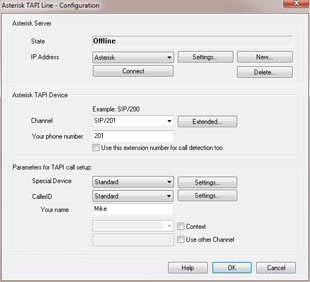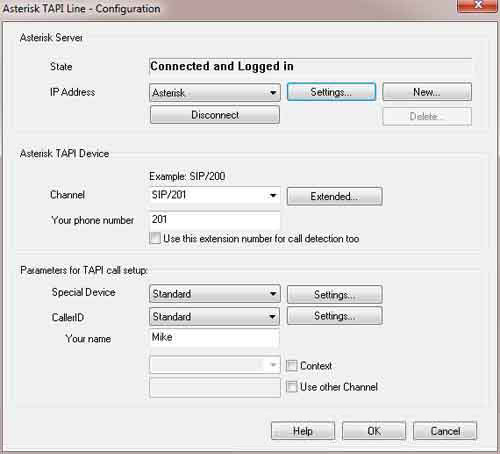TAPI Line Configuration
In first step you have to configure the Asterisk Server parameters.
TAPI Line Configuration - Device Parameter
Now you have to enter the parameters in section "Asterisk TAPI Device". The dialog image shows an example for a SIP phone with extension "201".
Channel: Your phone identifier within the telephone system.
Examples:
- SIP/200
- PJSIP/200
- IAX/200
- Zap/g1/11
- Zap/1
- Queue/600
- ParkPos/701 (ParkeeExten)
- ParkingSpace/555
- *280 (example to observe Hint "*280")
Your phone number: This is used as "callerID" and optionally for call detection.
Use this extension number for call detection too:This option may help to assing calls to your ZAP-channel. Default: Off
Parameters for TAPI controlled call setup
Special Device:
- If you use one of the listed phones, you can select this. The dialing commands are then sent directly to the telephone.
- "Standard" means no special device. In this case your phone is called from the Asterisk PBX first.
- The possibilities of "TAPI-controlled call setup" are relatively varied and in need of explanation. Therefore, the parameters are described on the following page:
- Functions such as "Answer" and "Hold" are usually also supported for selectable IP telephones.
CallerID:
Context:
If these settings are done the TAPI driver should work now.
Special Lines for "Hint" display
Example: With *280 the day/night-service can be switched in the system.
If you set Channel=*280, this TAPI-Line can be used to display an active night service.
The TAPI driver monitors the Manager Interface for ExtensionStatus events with "Exten: *280" and then sends a special LINE_ADDRESSSTATE event (LINEADDRESSSTATE_FORWARD + LINEADDRESSSTATE_DEVSPECIFIC). When the program starts, the command "core show hints" queries the Hint states of the system. Example AMI sequence.
If the TAPI application then queries lineGetAddressStatus(), the parameter LINEADDRESSSTATUS::dwDevSpecificSize contains, for example, "UserCustomInfo: ON" or "UserCustomInfo:" in the "off" state.In the CTI Client you can assign such a Line to a speed dial key with: Type=dial programming code, Name=Night service, Phonenumber=*280. An active night service should then be signaled with a blue LED. Clicking the speed dial button dials the *280 via the PhoneDialog line and thus switches the day/night service.

